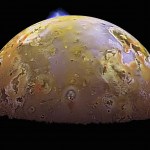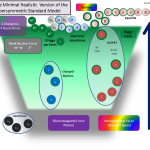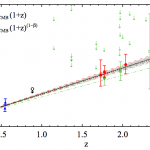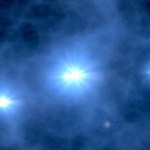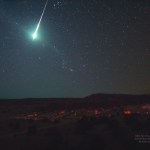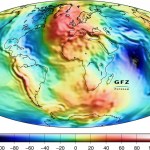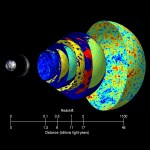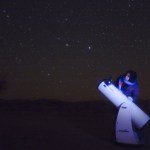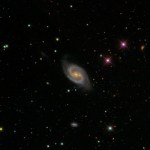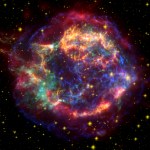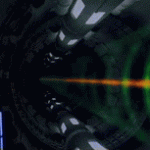
“The crust, being so thin, must bend, if, over wide areas, it becomes loaded with glacial ice, ocean water or deposits of sand and mud. It must bend in the opposite sense if widely extended loads of such material be removed. This accounts for… the origin of chains of high mountains… and the rise of lava to the earth’s surface.” -Reginald Daly, 1932
When you think about volcanoes, you quite likely think about magma -- liquid rock -- accumulating and welling up beneath the Earth's surface. Every once in a while, this ultra-hot liquid seeps through the Earth's surface, resulting in a spectacular…
A few weeks ago, Amanda Peet gave a public lecture that we live-blogged here. In the Q&A part after the talk, she made a statement that I sort of glossed over: that the LHC was able to verify some of the predictions of String Theory. In my head, I thought, "yeah, all the predictions that the Standard Model itself made, and nothing more." And I let it go.
Image credit: © WGBH Educational Foundation, via http://www.pbs.org/wgbh/nova/physics/conversation-with-brian-greene.html.
But maybe it's time to ask that question for real: will the LHC be able to test String Theory? And if so,…
It's one of the cardinal laws of physics and the underlying principle of Einstein's relativity itself: the fact that there's a universal speed limit to the motion of anything through space and time, the speed of light, or c. Light itself will always move at this speed (as well as certain other phenomena, like the force of gravity), while anything with mass -- like all known particles of matter and antimatter -- will always move slower than that.
Image credit: Matt Howard.
But if you want something to travel faster-than-light, you aren't, as you might think, relegated to the realm…
“The world exploded into billions of atoms, and when it rearranged itself, it may have looked the same, but really, it was a Whole New World.” -Claire LaZebnik
At the center of almost every galaxy is a supermassive black hole (SMBH); at the center of almost every cluster is a supermassive galaxy with some of the largest SMBHs in the Universe. And every once in a while, a galactocentric black hole will become active, emitting tremendous amounts of radiation out into the Universe as it devours matter.
Image credit: NASA/CXC/Ohio U./B.McNamara, via http://chandra.harvard.edu/photo/2005/ms0735/…
“I have made the most important discovery of my career, the most important discovery of my life: It is only in the mysterious equations of love that any logic or reason can be found.” -John Forbes Nash, Jr.
Yet logic and reason -- when applied correctly -- can get us incredibly far. Have a listen to Supertramp singing their unique hit,
The Logical Song,
while you consider the islander problem from TV's Brooklyn Nine-Nine.
Image credit: E. Siegel.
“There are 12 men on an island. 11 weigh exactly the same amount, but one of them is slightly lighter or heavier. You must figure out…
"An asteroid or a supervolcano could certainly destroy us, but we also face risks the dinosaurs never saw: An engineered virus, nuclear war, inadvertent creation of a micro black hole, or some as-yet-unknown technology could spell the end of us." -Elon Musk
We've covered a ton this week on Starts With A Bang, ranging from the earliest times to the ultra-theoretical to the present day and what's going on right here on Earth. Take a look back if you missed anything, as we've covered:
Where is the cosmic microwave background? (for Ask Ethan),
Raw ingredients, cubed (for our…
“[I]f there were no light in the universe and therefore no creatures with eyes, we should never know it was dark. Dark would be without meaning.” -C.S. Lewis
The Universe had two periods where light was abundant, separated by the cosmic dark ages. The first came at the moment of the hot Big Bang, as the Universe was flooded with, among the matter, antimatter and everything else imaginable, a sea of high-energy photons, including a large amount of visible light. As the Universe expanded and cooled, eventually the cosmic microwave background was emitted, leaving behind the barely visible,…
“The oldest and strongest emotion of mankind is fear, and the oldest and strongest kind of fear is fear of the unknown.” -H. P. Lovecraft
When it comes to risk assessment, there's one type that humans are notoriously bad at: the very low-frequency but high-consequence risks and rewards. It's why so many of us are so eager to play the lottery, and simultaneously why we're catastrophically afraid of ebola and plane crashes, when we're far more likely to die from something mundane, like getting hit by a truck. One of the examples where science and this type of fear-based fallacy intersect is the…
“Journalists often ask me when I go to the field, ‘What do you expect to find?’ And my answer always is, ‘The unexpected,’ because we’re just looking at the tip of the iceberg; we’ve just scratched the surface.” -Donald Johanson
Imagine you wanted to know what your acceleration was anywhere on Earth; imagine that simply saying "9.81 m/s^2" wasn't good enough. What would you need to account for?
Image credit: © 1999–2014 Michael Pidwirny, via http://www.physicalgeography.net/fundamentals/10k.html.
Sure, there are the obvious things: the Earth's rotation and its various altitudes and…
“One of the dreariest spots on life’s road is the point of conviction that nothing will ever again happen to you.” -Faith Baldwin
Bet you thought you knew it all about the asteroid belt. These frozen, ice-and-rock worlds orbit farther out from Mars, closer in than Jupiter, and occasionally get hurled towards the inner Solar System by gravitational interactions. But the largest world, Ceres, at just about half the diameter of the Moon (or the size of Texas), exhibits an unusual surprise: a brilliant set of white spots at the bottom of one of its largest craters.
Image credit: NASA/JPL-…
If you're not a theoretical physicist yourself, you might think that physics is physics -- we ask questions about the Universe, do experiments/make observations, and get the answers -- and math is just a tool that we use to help us get there.
Image credit: © 2015 Shaper Helix — II Demo, via http://www.alevelsolutions.com/pure-mathematics.
But that really sells the power of mathematics short. For a physical theory to be valid, there are a whole host of mathematical properties that theory needs to possess, including being free of logical inconsistencies, making predictions about observables…
“Without any doubt, the regularity which astronomy shows us in the movements of the comets takes place in all phenomena. The trajectory of a simple molecule of air or vapour is regulated in a manner as certain as that of the planetary orbits; the only difference between them is that which is contributed by our ignorance. Probability is relative in part to this ignorance, and in part to our knowledge.” -Pierre-Simon Laplace
Originating from well out beyond the planets we're accustomed to, the cold, icy worlds of the outer Solar System normally roam in isolation, hardly noticed by anything at…
“That’s what you get for being food.” -Margaret Atwood
Sure, we need food to live. But in our world of highly processed, easily-accessible foods, unless we're doing the prep and cooking ourselves, it's easy to lose touch with what the raw ingredients are actually all about. Have a listen to Australia-based band, The Middle East's amazing tune,
Pig Food,
while you consider the artistic achievement of the Dutch duo: Lernert & Sanders.
Image credit: Lernert & Sander, via http://lernertandsander.com/cubes/.
By taking 98 different foods and constructing 2.5 cm cubes out of…
“I do not think, sir, you have any right to command me, merely because you are older than I, or because you have seen more of the world than I have; your claim to superiority depends on the use you have made of your time and experience.” -Charlotte Brontë
Our exploration of the Universe, near and far, continues here on Starts With A Bang, as we've looked at the entire Universe, our local corner of it, dark matter and even the most human of issues. Make sure you catch up on anything you missed, including:
The shape of the Universe (for Ask Ethan),
The friends star (for our…
“We are told to let our light shine, and if it does, we won’t need to tell anybody it does. Lighthouses don’t fire cannons to call attention to their shining- they just shine.” -Dwight L. Moody
When it comes to the farthest thing we can see in the Universe, that's the Cosmic Microwave Background, or the leftover glow from the Big Bang, emitted when the Universe was a mere 380,000 years old. But what, exactly, does this mean?
Image credit: ESA and the Planck Collaboration.
Does it mean that we're seeing the "edge" of the Universe? Does it mean that there's nothing to see, farther back…
“Bad men need nothing more to compass their ends, than that good men should look on and do nothing.” –John Stuart Mill
If there's nothing else that science has to offer, it's this elegant notion: that anyone, anywhere, at anytime, can investigate and uncover the mysteries and workings of the Universe simply by asking it the right questions in the right ways, listening to its answers, and putting the pieces together for themselves. Anyone can do it.
Image credit: University of Baltimore.
Only, for various and sundry reasons, not everyone gets to do it. Some people don't have the…
“The privilege of a lifetime is being who you are.” -Joseph Campbell
When you think about dark matter, you probably think of a few things: how mass and gravity don't appear to line up, how there isn't enough normal matter to account for the motions we see on scales of galaxies and up, and how it's necessary to form the structure we see on the largest scales, from the early times of the cosmic microwave background to the cosmic web spanning billions of light years we see today.
Image credit: Tony Hallas, via http://www.qsimaging.com/gallery.html.
But what you might not realize is that…
“We live in a world that has narrowed into a neighborhood before it has broadened into a brotherhood.” -Lyndon B. Johnson
When you think of our own cosmic backyard -- our planets, Sun, the nearby stars, and even the closest galaxies to us -- you probably don't think of them in the context of the entire Universe. But if you want to understand where we come from and how we got to be this way, perhaps you ought to.
Image credit: J. W. Inman, of NGC 2543, via http://www.jwinman.com/starcharts/NGC%202543%20chart.htm.
We could have been a single, isolated galaxy hanging out all by our lonesome…
“And no one showed us to the land
And no one knows the where’s or why’s
But something stirs and something tries
And starts to climb towards the light” -Pink Floyd, Echoes
It's pretty difficult to imagine, but a little over 300 years ago, a supernova -- a dying, ultramassive star -- exploded, giving rise to such a luminous explosion that it might have shone as bright as our entire galaxy.
And nobody on Earth saw it.
Image credit: NASA and The Hubble Heritage Team (STScI/AURA); Acknowledgment: R. Fesen (Dartmouth) and J. Morse (Univ. of Colorado).
Located in the plane of our Milky Way galaxy…
“The regional governors now have direct control over their territories. Fear will keep the local systems in line. Fear of this battle station.” -Grand Moff Tarkin
Sure, the Death Star was the most fearsome battle station in the Universe, for a time. Capable of destroying a planet with a single blast from its (certainly antimatter-based) super laser, it was the most powerful force of destruction, long ago, in a galaxy far, far away.
Image credit: Lucasfilm / Star Wars: Episode IV, a New Hope. (Motion Picture); imgflip gif by E. Siegel.
But what about when the war ended? Surely, as we all…
